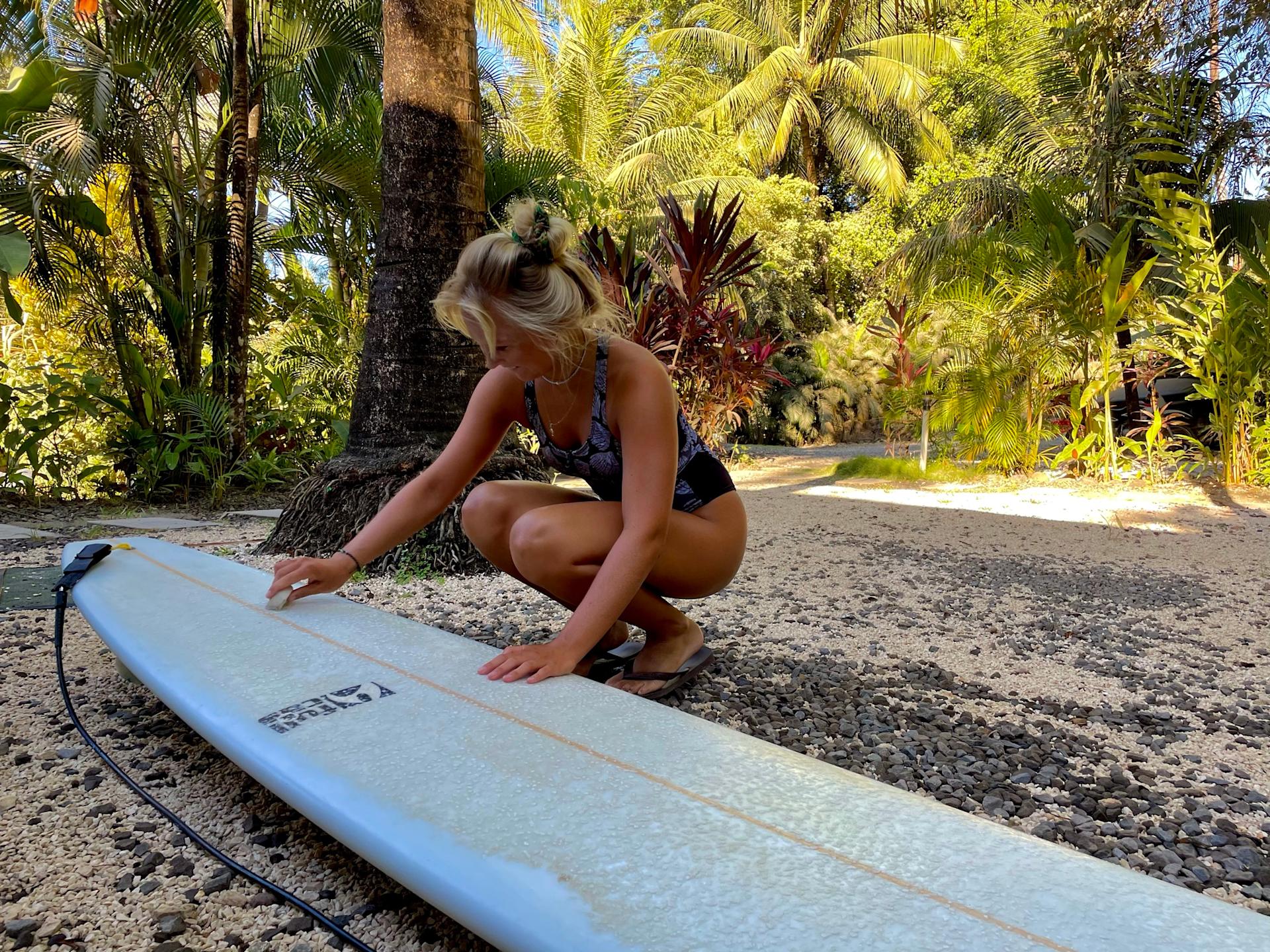
Surfboard anatomy – what are the parts of a surfboard and what do they do?
June 30, 2025It may feel overwhelming to understand all the parts of a surfboard. There are many different kinds of bottoms, fins and decks. What’s the nose? The tail? What are the things on the bottom of the surfboard called? What is in the middle of the board? Don’t worry, we’ll guide you through the different surfboard parts and what they are for. Let’s get down to the basics of surfboard anatomy!
Knowing the parts of the surfboard isn't just for the nerdiest surfers and the experienced surfboard shapers, it is important for the everyday surfer to know what’s on their board.
So this is where we come in, to help guide you through the construction of the surfboard! Not only is it good to know the parts to not come across as a total kook, but it will help you choose the right surfboard for you when it's time to buy your own.
The different parts of a surfboard – What are the parts of a board?
The illustration below shows the different parts of a surfboard, they all serve their own purpose in giving you the best ride possible down the wave. From water flow control and manoeuvrability to speed and stability. Although there are countless different boards and board types, the parts of them and the names apply to all.
The main parts of the surfboard:
Nose
Rails
Stringer
Deck
Bottom
Leash plug
Fins and fin plugs
Outline
Rocker
Tail
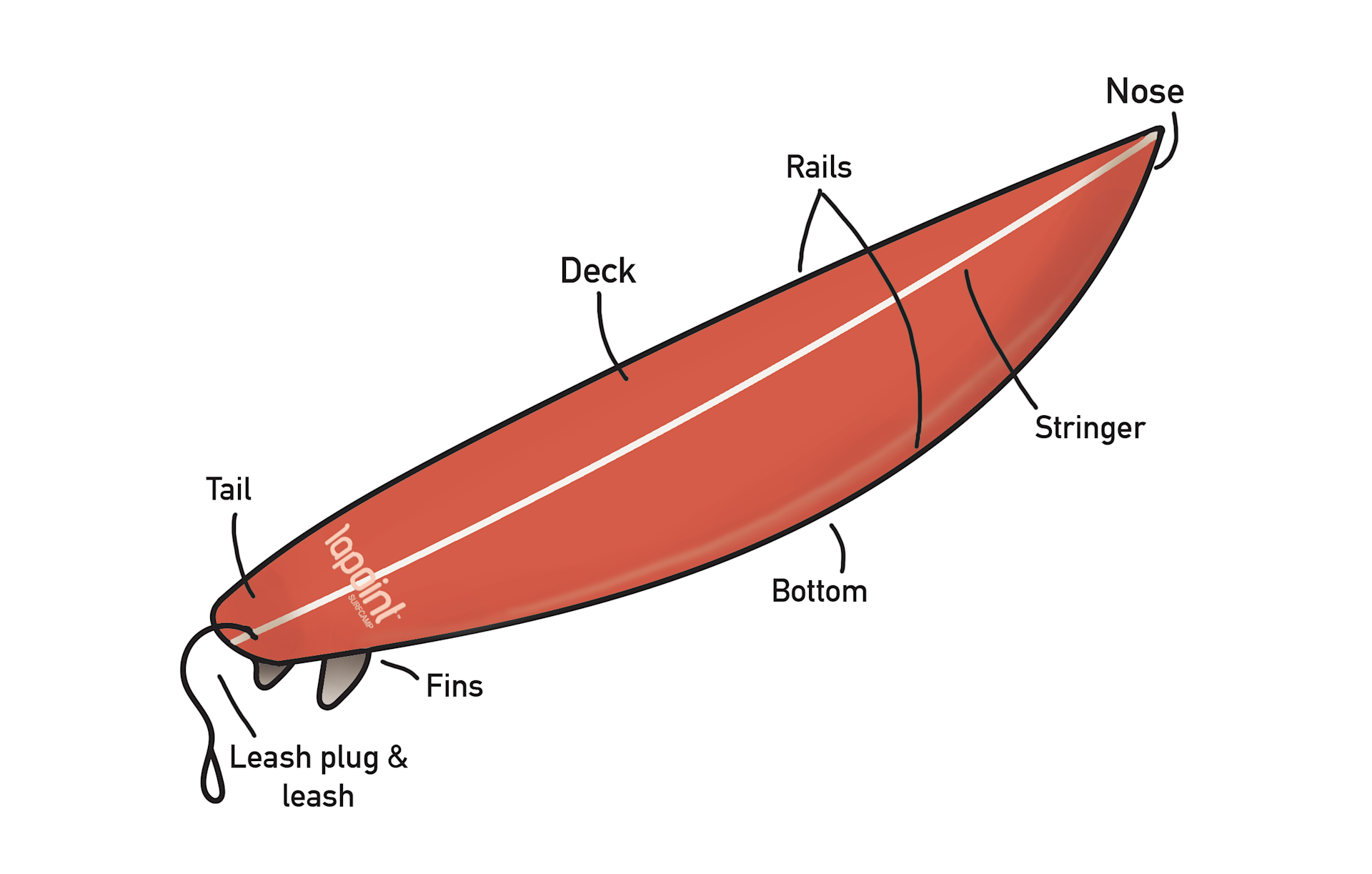
Nose
The nose of the board is the front part, the tip of the board. The arch is there so that you can manoeuvre the board better as you ride. The nose is either rounded or pointed: on longboards and funboards, you have probably seen that the nose is rounded, while on shortboards and fishes the nose is usually more pointed. Rounder noses are good to catch waves and a pointed nose is better for performance surfing.
Rails
The sides of your surfboard, or the edges, are called rails. The rails go from the nose of the board all the way to the tail. The performance of your board is affected by the shape of these since the rails are key parts of determining how the board flows in the water. When picking the rails you choose between soft rails and handrails, this doesn't refer to the hardness of the material but rather to the shape. Soft rails are more rounded and smooth and help with stability and make it easier to paddle, which is fitting for longboards. Hard rails are sharper and more squared (harder edges), these are good for increasing speed and turning quickly. These rails are less forgiving than soft rails and require more skills from the surfer to ride with.
Stringer
This is the (typically) wooden strip in the middle of the surfboard, going from the nose to the tail. The stringer is there to strengthen the board and to control the flex. However, some surfboards (like epoxy boards) don’t usually have a stringer.
Deck
The deck is what the top side of the surfboard is called; the side where you stand while surfing. It is on the deck you apply wax to increase grip.
There are different types of decks:
Flat deck: Just like the name reveals, this deck is flat. Usually, this deck got wider rails.
Dome deck: This deck has less volume at the rails and more volume in the centre, giving it a slight shape of a dome.
Step deck: This deck gives a similar feeling to standing on a skateboard. The deck has a platform and the rails are thinner/lower. When you’re watching the board from the rails you’ll notice that the step deck has a step on it.
Bottom
So, if we flip the board upside down, the downside of the board is simply called the bottom. This is the side of the board that will face the water (duh). Concaves, convex and flats are the main categories of surfboard bottom contours, although many boards are made of a combination. This part of the board is playing a big role in controlling how the water flows and how the board performs on it. The different kinds of bottom contours interact differently with the waves.
There are different types of surfboard bottom contours, the major ones are:
Concave bottom: A board has a concave bottom if a part of the bottom is lifted above the rail line. A concave bottom provides the board with a lift and gets a better glide, helps you to snap your rails to the face of the wave and can give you more control. There are different concave bottoms, like a single concave or a tri-plane hull.
Convex bottom: If a part of the bottom is dipping below the rail line, the board has a convex bottom. These bottoms are good for stability and transitioning from rail to rail. Convex bottoms are normally found on longboards. There are different convex bottoms, like a V or a belly.
Flat bottom: As you may have guessed, a flat-bottomed surfboard is flat and stays the same level as the rails. This bottom will help the board with speed generation but it doesn't do much for performance.
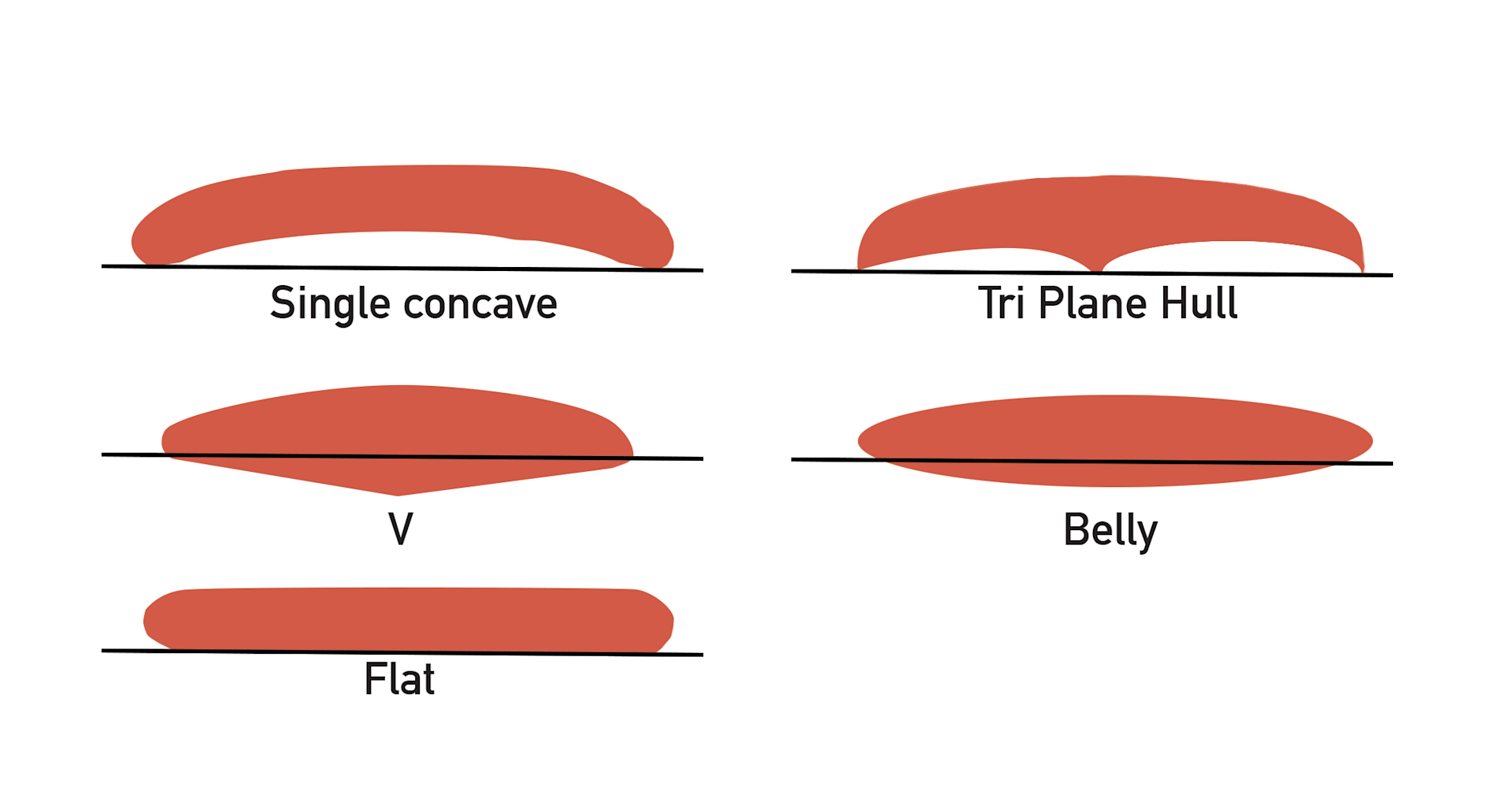
Leash plug
At the back of your board, next to the tail, you’ll find a leash plug. This is where you attach the leash; the leg rope that connects the board to the surfer. The leash is fastened around your ankle at one end and into the leash plug at the other. This is a safety measurement to keep the board from getting away from you after a wipeout.
Fins and fins plug
On the bottom side of the board, at the tail, you’ll find fin plugs. These are the plugs where you attach the fins. There are five different setups for fins: single, twin, thruster, quad fin and five fins. These come in a big variety of shapes and sizes. The fins are very important to steer the board, have a good water flow and have speed control.
Outline
The outline refers to the overall shape of the board. This can also be referred to as the template of the board.
Rocker

The rocker is the curvature from the surfboard's nose to the tail. The rocker helps to turn the board, the more dramatic the curve is the easier the board is to manoeuvre but it will also make the board slower. The format of the rocker is usually described as heavy (more sharp curve) or relaxed (the curve is less sharp). A relaxed rocker is more suitable for flatter waves.
Tail
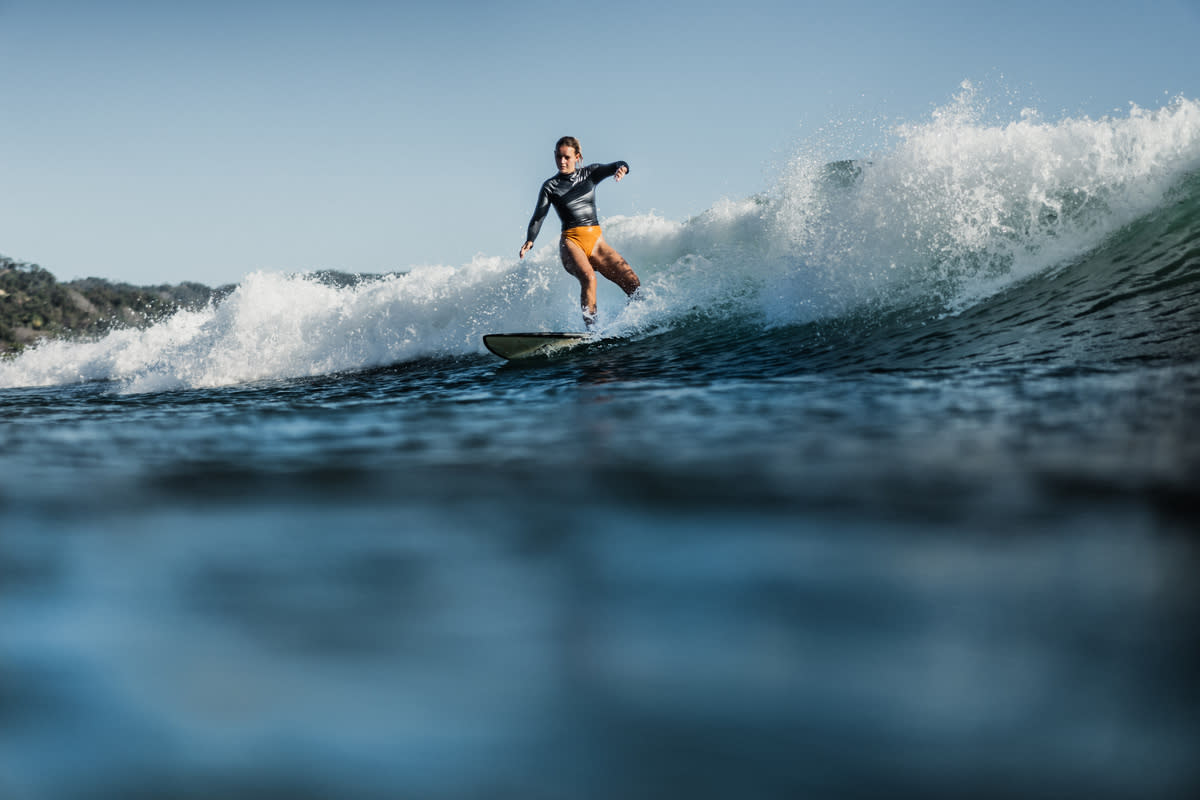
The back of the board is called the tail. There are different types of tails and they all have their own purpose for the board's performance. The most common tails are pin tails (common for big wave-boards), rounded tails (common for longboards), squash tails (common for shortboards) and swallow tails (common for fishboards).
Do you want to know more about how surfboards are made?
Check out this post where we talked to three surfboard shapers in Portugal on how a board goes from being a piece of foam to riding waves.
Surfboard anatomy: Q&A
What is the fin on a surfboard called?
The fin on a surfboard is simply called a fin, but depending on the setup, it can be part of a single fin, twin fin, thruster (three-fin), quad (four-fin), or five-fin configuration. Fins help with stability, control, and maneuverability.
What is the thing on the bottom of a surfboard?
The bottom of a surfboard consists of various features that impact water flow and performance. Some key elements include: fins, fin plugs and leash plugs.
Fins and fin plugs: for control and drive.
Leash plug: (near the tail) to attach a leash.
Concaves: (single, double, or V-shape) for speed and lift.
What does V do on a surfboard?
A V-bottom (or V-concave) refers to a shape where the bottom of the board forms a slight "V" along the stringer, typically towards the tail. It helps with rail-to-rail transitions, making turns smoother and easier. This is especially useful in bigger waves or on longboards for improved maneuverability.
Why do surfboards have 5 fins?
A five-fin surfboard doesn’t mean you surf with all five fins at once. Instead, it offers versatility—you can switch between different fin setups depending on wave conditions. Common configurations include:
Twin fin (two fins): for a looser, more playful feel.
Thruster (three fins): for balanced control and performance.
Quad (four fins): for speed and grip in bigger waves.
A five-fin setup gives surfers the option to experiment and adjust their board’s feel without needing multiple boards.
Can you surf with 5 fins at once?
Technically, you can surf with five fins at once, but it’s not common and generally not recommended. Surfing with five fins would create excessive drag, slowing you down and making the board feel stiff and unresponsive. The extra fin disrupts water flow, which can reduce maneuverability and speed.
That said, some experimental surfboard designs or custom setups might use five fins in unique ways, but for most surfers, sticking to thruster or quad configurations is the best approach.
NEWSLETTER
Stay up to date, sign up for our newsletter
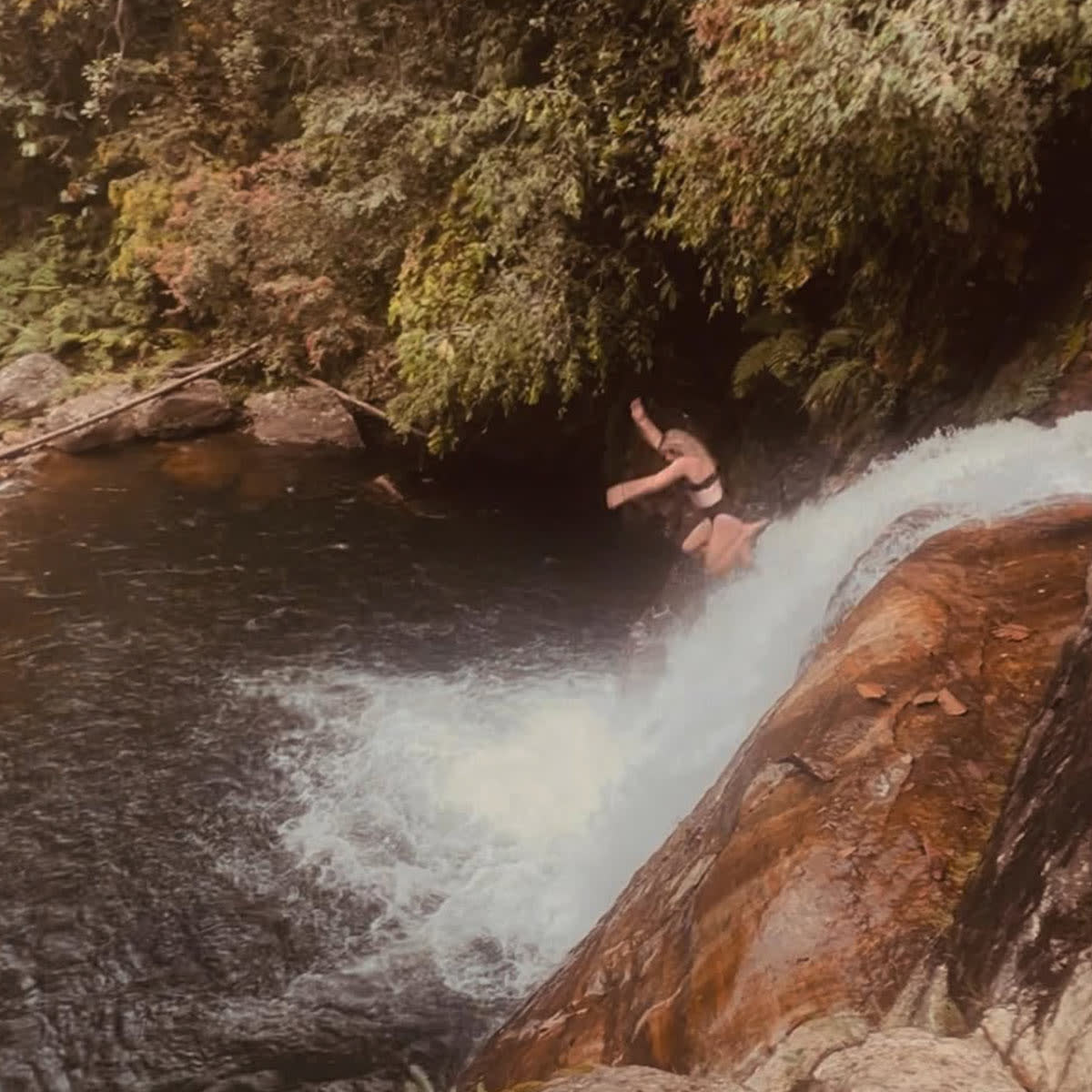
Beatrice Lindfors
About the author: My name is Beatrice, but Bea for short, and I’ve been a writer and content creator for Lapoint since 2022. My life revolves around my laptop and backpack as I travel the world (always with a stop in Ericeira; the camp vibe there and the Portuguese sunset have my heart). Life goal? Visit every country.
Obsession? The Sri Lanka waves, the Atlantic Ocean and tracking down the best coffee –whichever my current location is.

